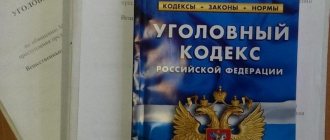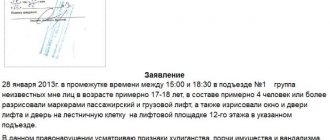In the Criminal Procedure Code of the Russian Federation today there are several articles of similar meaning that regulate criminal liability for damage caused by the theft of property values through the commission of various types of criminal acts.
These include:
- Art. 159 of the Criminal Code, regulating the degree of liability for fraud;
- Art. 7.2.1 of the Criminal Code, which establishes liability for causing damage by misappropriation of property values through abuse of trust or fraud;
- Art. 158 of the Criminal Code, regulating liability for theft;
- Article 7.27.1 of the Code of Administrative Offenses, which establishes liability for damage caused by petty theft.
The main and defining difference that separates them from each other is the size of the amount that serves as the basis for initiating a criminal investigation. In 2021, amendments were made to the Criminal Code under the articles listed above in the amount of amounts that trigger criminal liability.
Minimum amounts of damage for criminal penalties
It is necessary to distinguish between liability for similar elements of crime in the field of administrative and criminal Russian legislation.
The calculation of the amount of damage to initiate a case depends on this. To distinguish between elements of criminal acts, a set amount of damage is used. Lawyers point out that in 2021, important adjustments were made to the Criminal Code of the Russian Federation. When establishing the amount of criminal liability for crimes, you should study the provisions of the criminal law containing information about the minimum limit of damages. The amount of damage for opening a criminal case affects crimes involving property and other illegal actions (bribes, tax fraud, credit debts).
Let's consider how the amounts of damage caused to initiate a criminal case are established, according to which articles and rules they are calculated, whether convicted persons have the opportunity to apply for a mitigation of punishment or its abolition, and whether the perpetrators have the opportunity to avoid punishment and the associated consequences.
Criminal Code, Art. 167
In order to understand what we are talking about, let’s consider what the article of the Criminal Code says about the subject of the crime. What is significant damage under the Criminal Code of the Russian Federation?
The subject of the crime is the property of the other party (the defendant), the damage to which was, in fact, caused. That is, significant damage can be called not only the destruction, but also damage to the property of another citizen.
The subject of the crime must have a marketable value, that is, a price that can be determined by an objective method. As for the conditions under which the crime was committed, they also matter. In the modern world, we increasingly hear about terrorist acts and vandalism; for these conditions, other relevant articles of the criminal code are defined, which provide for a completely different punishment.
In order to have a clear distinction between the destruction of property and its damage, let us consider what the Criminal Code defines as the destruction of property and its damage.
Amounts of damage for criminal liability and calculation features
Ch. 21 “Crimes against property” of the Criminal Code of the Russian Federation contains a list of amounts and definitions of basic concepts, which include large, significant and especially large harm caused to the victim. More detailed information is contained in Art. 158 of the Criminal Code of the Russian Federation - in the notes.
In N 323-FZ 07/3/2016 certain adjustments were developed, according to which:
- amount of significant damage – from 5 thousand rubles;
- amount of major damage – from 250 thousand rubles;
- the size of an especially large one is 1 million rubles.
Part 1 art. Code of Administrative Offenses 7.27 “Petit theft” describes punishment in the amount of up to 1 thousand rubles. Part 2 art. 7.27 – punishment for theft in the amount of 1 to 2.5 thousand rubles.
As a result, the innovations led to the following uncertainty: theft in the amount of 2.5-5 thousand rubles. - This is not yet an administrative illegal act, but it is no longer a criminal offense. The Code of Administrative Offenses of the Russian Federation does not yet contain new amendments and adjustments.
Officially, the Criminal Code of the Russian Federation does not apply the concepts of minor and significant harm.
There are certain crimes against property. For them, the legislation establishes other amounts that act as an exception.
Responsibility measures
For each violator, it matters not only how much the act is qualified as a crime, but also what the penalties are.
The following alternative punishment options are relevant for fraud:
- Material penalty in the form of a fine, up to 120,000 rubles, or within the limits of the salary or other income of the convicted person for 12 months;
- Compulsory work - here different durations are established, but not more than 360 hours;
- Correctional labor, in which a convicted person can remain for up to 1 year;
- Restriction of human freedom - the maximum term cannot be more than 2 years;
- Forced labor for the same period as restriction of freedom;
- Arrest lasting no more than 4 months;
- Imprisonment for up to 2 years.
At the same time, approximately the same limits are set for theft, the types of impact remain the same, as in fraud.
Note! The indicated amounts and types of penalties are relevant for significant damage; if we are talking about large amounts, then the types of penalties change. In addition, for large and especially large sizes, more serious forms of punishment are provided.
Special procedure for fraudulent activities
Special articles contain rules used to determine the amount of damage. But there are exceptions, which include the following.
Part 5 art. 159 “Fraud” considers a person’s refusal to perform contractual actions in the field of business, which ultimately causes significant harm. The same applies to part 6 of the same article, only major harm is already considered, and in part 7 – especially large harm.
It also provides for punishment for fraudulent activities in the field of lending (Article 159.1), the use of bank cards (Article 159.3), insurance (159.5), and computer data (Article 159.6).
For the articles considered in 2021, the amount of damage and the rules for calculating it differ from the standard ones.
In 2021, according to the Criminal Code of the Russian Federation, the amount of significant damage is from 10 thousand rubles, large - from 3 million rubles, especially large - from 12 million rubles. Such amounts of damage for initiating a criminal case are explained by the fact that companies and individual entrepreneurs become parties to the agreement.
This article appeared in the legislation of the Russian Federation not so long ago. So far, the attitude towards it from specialists is ambiguous.
Let's sum it up
- The employee compensates for material damage to the employer only in special cases established by law.
- Lost profits and lost income cannot be recovered. Only direct actual damages can be recovered from an employee.
- It is the employer's responsibility to establish the exact amount of damage caused to property.
- If the damage was the result of a crime or offense, its recovery requires a court verdict or a decision on administrative liability.
- It is impossible to recover overpaid wages from an employee if this was not his fault and not as a result of a calculation (mathematical) error.
Unlock access to the private part of Clerk with a Premium subscription. Get hundreds of webinars and online courses, unlimited consultations and other proprietary content for accountants.
Hurry up to subscribe with a 20% discount until October 15, 2021. Read more about “Premium” here.
Changes to the Criminal Code of the Russian Federation for companies and individual entrepreneurs: determining the amount of damage under individual articles
- Art. 169, dedicated to obstructing entrepreneurship and other activities, considers the concept of major harm, the amount of which is from 1.5 million rubles.
- In Part 3 and Part 4 of Art. 171.1, the concept of large size is studied, the amount of which is from 400 thousand rubles, and especially large - no less than 1.5 million rubles.
- In Part 5 and Part 6 of Art. 171.1, the concept of large size implies 100 thousand rubles, especially large - 1 million.
- For Art. 171.2 major damage - at least 1.5 million rubles, especially large damage - from 6 million rubles.
- In Art. 178 of the Criminal Code of the Russian Federation deals with punishment for restricting competition. It has not been subject to adjustments or updates. According to it, large income is from 50 million rubles, especially large - from 250 million rubles. Major damage, in accordance with this article, ranges from 10 million rubles, especially large damage – from 30 million.
- For Art. 180 the amount of major damage is from 250 thousand rubles.
- Art. 184 of the Criminal Code of the Russian Federation considers the concept of significant harm, the amount of which starts from 25 thousand rubles.
- For 4 articles (Articles 185, 185.1, 185.2 and 185.4) it is established that the amount of major damage starts from 1 million rubles, and especially large damage – from 3.75 million.
- According to Art. 185.3 of the Criminal Code of the Russian Federation for the dissemination through the media of information that does not correspond to reality, the amount of major damage is from 3.75 million rubles, especially large – from 15 million.
- Art. 185.6 is devoted to liability for the illegal use of official information for one’s own purposes. According to it, the amount of major damage is 3.75 million rubles. The same amount appears in the concepts of major losses and profits.
- Art. 191.1 contains notes according to which illegal actions with wood are established for a large size in the amount of 80 thousand rubles, especially large - from 230 thousand rubles.
- Art. 193.1 of the Criminal Code of the Russian Federation for currency transactions establishes a large amount in the amount of 9 million rubles. for 12 months, especially large – from 45 million.
- Art. 194 for failure to fulfill payment obligations establishes that the amount of major damage is from 2 million rubles, especially large – from 6 million.
This is an incomplete list of articles. It is necessary to emphasize that the spread is significant. In relation to individuals and crimes against property, the number of exceptions is small.
Chapter 22, which deals with economic crimes, contains exceptions in almost every article. The explanation lies in the complexity, the danger to society, in special circumstances, which include the organization of work in the field of economics and entrepreneurship.
In criminal law, laws 323-FZ and 326-F, adopted in the summer, adjusted the amounts of damage. These innovations apply to those who stole property in the winter and autumn months of 2021 and later, as well as to those who were convicted and are serving a prison sentence for the theft.
Qualifying features
The Criminal Code of the Russian Federation provides two qualifying criteria for this crime (Article 165 of the Criminal Code of the Russian Federation). Both of these signs are indicated in Part 2 of Article 165 of the Criminal Code of the Russian Federation:
- Clause “a” of part 2 of article 165 of the Criminal Code of the Russian Federation.
This paragraph provides for punishment for causing property damage that was committed by an organized group or a group of persons by prior conspiracy. The difference is that an organized group is a more hierarchical and stable structure, the participants have a clear plan, according to which they distribute roles and tasks for each of them. Moreover, most often, individuals uniting in an organized group plan to commit not just one crime, but a whole series.
The commission of a crime by a group of persons by prior conspiracy is characterized by:
- two or more persons agreed in advance that they would commit a crime;
- they know about each other’s existence and that they will carry out criminal actions (the objective side of the crime) together, that is, the joint execution of the objective side is covered by the intent of each of them.
However, in this case we cannot talk about the structure or any complex organization of the group.
- Clause “b” of Part 2 of Article 165 of the Criminal Code of the Russian Federation.
Provides for the infliction of property damage, which was committed not on a large scale, but on an especially large scale. We remind you that the criteria for the amount of damage are established in the note to Article 158 of the Criminal Code of the Russian Federation. In accordance with this note, the amount of damage exceeding one million rubles is recognized as particularly large.
Example 1.
Rylov D.A. together with a limited liability company, they created a new legal entity, of which D.A. Rylov became its director. Moreover, he bought out a 90% share, thus becoming the only participant in the created legal entity.
This legal entity - LLC Management Company "MODO COMFORT" - was engaged in the management of apartment buildings: hot and cold water supply, heating, electricity - everything that is required for the operation of an apartment building. In order to provide hot water supply and heating, D.A. Rylov, who is also the director of MODO COMFORT Management Company LLC, entered into an energy supply agreement with KTK JSC.
Money that came from residents of an apartment building to pay for heating and hot water supply, D.A. Rylov. should have been transferred to KTK JSC as payment under the energy supply agreement. Rylov D.A. understood that payments can be made sporadically, the frequency of payments depends on the amount, moreover, he understood that in accordance with the Decree of the Government of the Russian Federation dated May 6, 2011 No. 354, KTK JSC cannot interrupt supplies under the energy supply contract. That is why Rylov D.A. at a certain point, he stopped transferring funds to the account of KTK JSC.
The Oktyabrsky District Court of the city of Kirov found D.A. Rylov guilty. of committing a crime prohibited by paragraph “b” of part 2 of Article 165 of the Criminal Code of the Russian Federation, sentencing him to imprisonment for a period of 1 year 6 months. However, the court considered it necessary to consider this punishment suspended, and the probationary period was assigned to two years.
Example 2.
A. A. Teslin implemented a similar criminal scheme. He was also the director of a limited liability company that was engaged in servicing apartment buildings.
He entered into an agreement with another legal entity (as you can already guess, it later became a victim in a criminal case, as it suffered from the actions of Teslin A.A.). In accordance with this agreement, another legal entity supplied electricity to one of the apartment buildings, the maintenance of which was carried out by a limited liability company, the director of which was Teslin A.A.
The residents of the house transferred money to the management company, and Teslin A.A. transferred them to the counterparty. However, he realized that even if he did not transfer funds to the electricity supplier, its supply to the apartment building would not stop, since both the Housing Code and Government Resolution No. 124 of February 14, 2012 protect citizens - residents of apartment buildings. That is why Teslin A.A. stopped transferring money to the counterparty’s account, thereby causing property damage to the victim.
The Dzerzhinsky District Court of Orenburg found A.A. Teslin guilty. in committing a crime prohibited by part 1 of article 165 of the Criminal Code of the Russian Federation. From the actions of Teslin A.A. Not only did this legal entity suffer, he committed several such crimes at once. The court sentenced him to imprisonment (one and a half years, suspended) and a fine of five hundred thousand rubles.
Changes for convicts serving prison sentences
At the moment there is decriminalization. It represents the transfer of minor criminal offenses to the category of administrative offenses. Art. 10 of the Criminal Code of the Russian Federation establishes the fact that a law mitigating or exonerating liability has retroactive force. For this reason, convicted persons have the right to draw up petitions with a request to release them and mitigate their responsibility.
The completed petition is sent to the judicial authority at the address of the location of the correctional institution - pre-trial detention center, penal colony, penitentiary institution, penitentiary institution. Authorized persons do not have the right to prevent the submission of an application.
Compensation for damage before the initiation of a criminal case
The situation for those who compensate for damage before the initiation of a criminal case has also changed. It is necessary to consider Art. 76.1 of the Criminal Code of the Russian Federation as amended on July 3, 2016, which is devoted to exemption from criminal punishment when committing economic crimes. It examines the likelihood of exemption from crimes committed in the field of tax legislation (for example, evasion of obligations to pay them). This opportunity is provided for those people who compensate for the damage caused to the budget of the Russian state.
In Part 2 of Art. 76.1 lists the circumstances under which the perpetrator can avoid criminal punishment if, before the initiation of a criminal case, he has fully paid all the damage caused.
In 2021, changes were introduced that consider the likelihood of exemption from criminal punishment when the following factors are established simultaneously.
- The person committed a crime for the first time.
- The person organized a crime, which is included in the list in Part 2 of Art. 76.1.
- The person has fully paid for the damage suffered by another individual, company or government.
- The person transferred to the budget an amount that is 2 times the amount of damage. Moreover, until 2021 it was necessary to transfer compensation in the amount of 5 times more damage.
If the offender commits all of the above actions, then he is released from criminal punishment. He will no longer have to go to court and government agencies, he will not have a criminal record, which has a negative impact on his future life.
If the offense is committed for the first time, then the state “forgives” him for this.
Establishing the amount of damage in conditions of changing exchange rates
The Plenum Resolution entitled “On judicial practice in cases of theft, robbery and robbery” contains the rules. Authorized persons use them to calculate the amount of damage.
- To establish the amount of theft, the actual value of the property on the date of the crime is used.
- If information about the value at the time of the crime could not be found, you need to seek help from experts. Specialists draw up acts on the basis of which the value of the property is then established.
- The damage that must be compensated is determined in accordance with the value of the property on the date of the decision on compensation and compensation. It is possible to index the value of property on the date of execution of the decision.
- Separate rules are provided for objects of special socio-cultural value. In order to correctly establish their value, it is necessary to invite experts who will draw up an act and write down in it the monetary value of a particular object and its significance for society, the cultural and scientific sphere of life.
- If controversial or conflict situations arise, you will need to seek help from an independent expert. However, choosing the person responsible for paying for his services is a separate issue.
If the theft involved foreign currency, then the amount of damage is calculated at the Central Bank exchange rate at the time the crime was committed.
The law also defines moral damage, which resulted in suffering, loss of ability to work, humiliation, and stress for the victim. It is calculated in monetary terms on an individual basis by the court. To compensate for moral damage, the victim must have documentary evidence on hand.
Crimes against property without signs of theft.
Some mercenary crimes have an external resemblance to certain forms of theft and coincide with them in subjective characteristics, but do not have the main sign of theft. The seizure of someone else's property is either not part of their objective side, or they are not related to the circulation of the seized property in favor of the perpetrator or other persons and do not have such a goal.
Current legislation recognizes three types of mercenary crimes that are not theft: extortion (Article 163 of the Criminal Code), causing property damage by deception or breach of trust (Article 165 of the Criminal Code), unlawful taking of a car or other vehicle without the purpose of theft (Article 166 of the Criminal Code ).
Extortion (Article 163 of the Criminal Code). Extortion is defined in law as a demand to transfer someone else's property or rights to property or to commit other actions of a property nature under the threat of violence or destruction or damage to someone else's property, as well as under the threat of disseminating information that disgraces the victim or his relatives, or other information that could cause harm. significant harm to the rights or legitimate interests of the victim or his relatives.
Direct objects
extortion, in addition to property relations, is the honor and dignity of the victim and his relatives, as well as their personal integrity and health.
To the victims
in case of extortion, there may be a person who owns, maintains or is under the protection of the required property, as well as his relatives.
Subject
extortion can be: someone else's property, the right to someone else's property, as well as other actions of a property nature that the victim must perform in response to the illegal demand of the extortionist in his favor.
Some scholars believe that the concept of property also covers the right to property, and propose to exclude reference to such a right from the disposition of Art. 163 of the Criminal Code (See: Kochoi S.M.
Criminal liability for extortion // Proceedings of the Kirov branch of the Moscow State Law Academy. No. 4. Kirov, 2000. P. 12.). One can hardly agree with this position, since it is based on a confusion of the concepts of “property rights”, which are actually included in property, and “right to property”. Therefore, the inclusion of the right to property in the subject of extortion is quite justified.
Objective side
consists of the actions of an extortionist aimed at forcing a person to transfer the required property or the right to it to the culprit or the persons he represents, or to perform some other actions of a property nature in the interests of the culprit or the persons he represents. If in the case of theft the culprit himself, against the will of the owner or the owner of the property, takes possession of it, then in extortion the victim is forced by threats of violence, destruction or damage to property or the dissemination of information undesirable for the victim to personally transfer the property or the right to it to the culprit or commit property actions in favor of the extortionist (See: Resolution of the Plenum of the Supreme Court of the RSFSR dated May 4, 1990 No. 3 “On judicial practice in cases of extortion” // RSFSR Air Force. 1990. No. 7; RF Air Force. 1992. No. 11.) .
Compound
extortion is designed as formal, therefore the fact of transfer of property to the perpetrator may take place some time after the extortion, or may not take place at all: the crime is considered
completed
from the moment an illegal demand is presented, supported by appropriate threats.
Requirement to transfer title to property
means an offer, accompanied by a corresponding threat, to give the extortionist or the persons he represents such a right, using which he will be able to obtain property or other material benefit (a certain amount of money, use residential or non-residential premises, a vehicle, etc. for free or on extremely favorable terms) .
Under the commission of other actions of a property nature
refers to such legally significant actions of the victim, as a result of which the extortionist or the persons represented by him receive property benefits or get rid of material costs (for example, destroying the extortionist’s promissory note, paying off his debt, performing some work for him, etc.).
The means of forcing the victim to transfer property, the right to it or to commit other actions of a property nature in favor of the extortionist or the persons represented by him are: the threat of violence against the victim or his relatives; threat of destruction or damage to property; threat of dissemination (i.e. making public) information disgracing the victim or his relatives, or other information, the disclosure of which could cause significant harm to the rights or legitimate interests of both the victim and his relatives.
Since the nature of the violence threatened by the extortionist is not specified in the law, it can be anything. The threat of murder is covered by extortion and does not require additional qualification under Art. 119 CC.
The implementation of the threat of destruction or damage to property goes beyond the scope of extortion and requires additional qualifications under Art. 167 of the Criminal Code.
If the extortionist divulges information that discredits the honor and dignity of the victim or his relatives or undermines their reputation and is deliberately false, then the act, in addition to extortion, contains elements of slander.
Subjective side
extortion is characterized by direct intent. In this case, the perpetrator is guided by a selfish motive and pursues the goal of illegally obtaining property benefits or evading material costs.
Subject
extortion - a person who has reached the age of 14 years.
Qualified staff
Extortion (Part 2 of Article 163 of the Criminal Code) is characterized by its commission
by a group of persons by prior conspiracy
(clause “a”), with
the use of violence
(clause “c”) or
on a large scale
(clause “d”).
The first and third qualifying characteristics coincide in content with the same characteristics in case of theft. The second sign includes violence that is not associated with harm to health (restriction of freedom, beatings, mockery, etc.), as well as violence that caused light or moderate harm to health.
Particularly qualified staff
extortion (Part 3 of Article 163 of the Criminal Code) means its commission:
by an organized group
(clause “a”);
in order to obtain property on a particularly large scale
(clause “b”);
causing grievous harm to health
(clause “c”).
The first sign has the same content as in the case of theft. The second means that the extortionist demands to transfer to him property the value of which exceeds 250 thousand rubles, or demands to transfer to him the right to property in the same amount or to perform other actions of a property nature, the result of which should be the receipt by the perpetrator of a property benefit in a large amount (over 250 thousand rubles).
Infliction of grievous bodily harm is the consequences that were caused to the victim as a result of coercion to fulfill the illegal demands of the extortionist or as a result of violence applied to the victim. These consequences are fully covered by the elements of especially qualified extortion and do not require additional qualifications under Art. 111 of the Criminal Code. However, if as a result of causing grievous bodily harm, the death of the victim occurred, which was not covered by the intent of the perpetrator, then the act must be qualified under the totality of paragraph “c” of Part 3 of Art. 163 and part 4 of Art. 111 of the Criminal Code.
Extortion, coupled with the threat of violence, must be distinguished from related crimes, in particular robbery and robbery.
The threat of violence during robbery serves as a means of seizing property, and during extortion it acts as a means of forcing the victim to apparently voluntarily transfer property to the perpetrator. In robbery, the perpetrator threatens to use violence that is not dangerous to life or health, and in extortion, the nature of the violence threatened by the perpetrator is not specified in the law. Robbery consists of taking someone else's property, therefore, causing property damage to the victim is a mandatory sign of the objective side, and in extortion, the transfer of property to the perpetrator is outside the scope of the objective side of the crime.
Extortion differs from robbery in the following ways.
Firstly, an obligatory sign of robbery is an attack, and extortion does not necessarily include this element.
Secondly, robbery involves the threat of violence dangerous to life or health, and with extortion there is a possible threat of any violence, including the threat of murder; in addition, it may be of a generally indefinite nature.
Thirdly, and this is the most important distinguishing feature, in the crimes being compared the threat has a different purpose. In robbery, the threat aims to overcome possible resistance to illegal seizure of property, i.e. serves as a method of directly taking possession of someone else’s property or withholding it, and in extortion it is a means of forcing the victim to agree to transfer the required property. The ransomware seeks not to capture
someone else's property, but
to receive
it from the hands of a coerced person. In case of refusal to hand over the required property, the culprit may carry out the threat, or may not carry it out at all.
Fourthly, during a robbery the perpetrator threatens immediate
the use of violence, and in extortion, by implementing threats, it is assumed not at the time of its utterance, but
in the future,
more or less close. If the perpetrator carries out the expressed threat, then without taking possession of property at the time of violence; otherwise, extortion develops, depending on the nature of the violence, into violent robbery or robbery.
Threats during extortion can be addressed not only to the victim, but also to his relatives. These include close relatives, husband, wife, as well as other persons who are in such a special relationship with the victim that the threat of violence against them can force the person to transfer the required property.
Causing property damage by deception or abuse of trust (Article 165 of the Criminal Code). The crime provided for in Art. 165 of the Criminal Code, may infringe on the rights of any owner or other possessor of property.
From the objective side
a crime is characterized by actions consisting of deception or abuse of trust placed in the perpetrator, resulting in property damage to the owner.
In terms of the methods of committing it (deception or breach of trust), it is very similar to fraud, but differs from it in another mechanism for extracting illegal property benefits. Fraud, like other forms of theft, is characterized by the fact that as a result of the illegal actions of the perpetrator (illegal seizure and conversion to one’s own benefit), someone else’s property comes into his possession, i.e. Due to illegal withdrawal from the cash funds of one or another owner, the cash balance of this property is reduced. The methods of committing the crime in question - deception or breach of trust - have the same factual content as in fraud. However, the culprit derives illegal benefit not at the expense of the property located in the owner’s cash funds, but through the unlawful seizure of property that has not yet been received, but in accordance with the law, another regulatory act or agreement must be received in these funds. Thus, in the case of theft, the damage consists of direct losses,
a reduction in the cash mass of existing property, and damage caused by deception or abuse of trust means failure to receive what is due -
lost profits.
Committing a property crime by breach of trust
in practice, it is most often expressed in the use of someone else’s property, entrusted to the guilty person, not in accordance with its intended economic purpose, but to satisfy the needs of the guilty person without paying the owner proper compensation.
So, according to Art. 165 of the Criminal Code should qualify the actions of a mechanic at a car service station who, having completed work not specified in the work order, turns the payment received from the client into his own property, as well as the chief engineer of a printing house who turns into his property the payment for an unaccounted circulation of ordered products. It is necessary to keep in mind that the use of materials belonging to the owner or other legal owner of the enterprise when executing a “left” order is not covered by the crime in question and requires additional qualification as theft of someone else’s property in the appropriate form (embezzlement or theft).
Causing property damage by deception
often expressed in the evasion of the perpetrator from paying mandatory payments and is qualified under Art. 165 of the Criminal Code, provided that the act does not contain signs of crimes under Art. 194, 198, 199 and 1991 CC. In these cases, it is especially important to distinguish the crime in question, in which, as the legislator emphasized, there are no signs of theft, from fraud.
For example, submitting a false certificate to the pension authority indicating that you have the required work experience in a hazardous industry and unjustifiably receiving a corresponding pension supplement should be classified as fraud. And the submission to the accounting department of the unified settlement center at the place of residence of a fake certificate of the presence of dependents in order to reduce the amount of utility bills contains elements of causing property damage by deception. In the first case, profit is made through illegal payments from the state pension fund (non-budgetary fund), and in the second - due to the fact that money that should go to the local budget was illegally withheld by the culprit.
Compound
the crime is
material,
therefore it is recognized as completed not from the moment of deception or abuse of trust, but from the moment of actual infliction of property damage to the owner. A causal relationship must be established between the unlawful actions of the perpetrator and the resulting consequences.
Subjective side
characterized by guilt in the form of direct intent. Guided by a selfish motive, the perpetrator pursues the goal of extracting illegal property benefits.
Subject
The crime can only be committed by a private person who has reached the age of 16 years. When the same actions are performed by an official using official powers, the act should be qualified, depending on the specific circumstances of its commission, as abuse of official powers (Article 285 of the Criminal Code) or as receiving a bribe (Article 290 of the Criminal Code). If the same actions are committed by a person performing managerial functions in a commercial or other organization, using his powers contrary to the legitimate interests of this organization, then the act must be qualified under Art. 201 of the Criminal Code, and under certain conditions - under Part 3 or 4 of Art. 204 CC.
Qualified staff
a crime (Part 2 of Article 165 of the Criminal Code) provides for its commission
by a group of persons by prior conspiracy
or
on a large scale.
In their content, these signs do not differ from similar signs of theft of someone else's property.
Particularly qualified staff
the crime in question occurs if the act:
a) committed by an organized group;
b) caused particularly large damage (Part 3 of Article 165 of the Criminal Code). The first sign in content coincides with the sign of the same name for especially qualified types of theft or extortion. The second sign reflects the specificity of the crime in question: the fact that it is not related to the taking of someone else’s property. The legislator associates increased liability for the crime in question not with a particularly large amount (as in the case of theft), but with the infliction of particularly large damage.
When establishing it, one should be guided by the same quantitative criterion that is established for especially large-scale theft (Note 4 to Article 158 of the Criminal Code).
In judicial practice, acts such as the “theft” of thermal and electrical energy and other similar acts are classified as causing property damage by deception, since they are characterized by the absence of a material attribute of the subject of theft.
Wrongful seizure of a car or other vehicle without the purpose of theft (Article 166 of the Criminal Code). Subject
The crime in question can be any vehicles, with the exception of those that fall under the concept of air or water transport vessels or railway rolling stock (Article 211 of the Criminal Code).
Objective side
characterized by actions that violate the right to own and use vehicles belonging to the owner or another owner. Wrongful possession means establishing the actual possession of vehicles by a person who does not have the legal right to own them. Therefore, the unauthorized use of vehicles by one of the owner’s family members or even close acquaintances, who were previously allowed to use them without obtaining the owner’s prior consent, does not constitute this offense. Cannot qualify under Art. 166 of the Criminal Code and unauthorized possession of a vehicle when a person used it by virtue of his position (for example, the driver assigned to it temporarily used the car).
Compound
unlawful taking of vehicles
formal;
the crime is considered
completed
from the moment the illegal actions are committed. Taking possession of a vehicle must be considered completed from the moment it begins to be used for its intended purpose, i.e. from the beginning of movement by self-propelled or other means.
Subjective side
characterized by guilt in the form of direct intent. In this case, the culprit, as a rule, is guided by a selfish motive - he strives to use other people's vehicles in his own interests. However, liability under Art. 166 of the Criminal Code is not excluded in cases of theft of vehicles for other reasons: revenge, hooligan motives, etc.
As emphasized in the law, taking possession of vehicles does not serve the purpose of stealing them. If their possession is carried out for the purpose of stealing at least part of them (for example, for dismantling a car and subsequent use of its individual units, components and parts), the act must be qualified as theft of someone else's property. The theft of someone else's car without the purpose of theft, but with the theft of property located inside the car, forms a combination of taking possession of a vehicle with the theft of someone else's property.
Subject
a crime may be committed by a person who has reached the age of 14 years.
Qualified staff
unlawful seizure of a car or other vehicle (Part 2 of Article 166 of the Criminal Code) provides for the commission of this act by a group of persons by prior conspiracy (clause “a”) or with the use of violence not dangerous to life or health, or with the threat of such violence (item “c”).
Preliminary conspiracy
group of persons means that two persons (or more) previously, i.e. before the start of the crime, agreed on the joint unlawful seizure of someone else’s car or other vehicle, without pursuing the goal of stealing it. A crime is considered a group crime if its participants directly carried out the objective side; in other cases, the actions of each of the accomplices are qualified according to the general rules of complicity, taking into account the role of each.
A sign of the use of violence that is not dangerous to life or health,
or
the threat of such violence
has the same content as violent robbery. When committing this crime, violence or the threat of its use acts as a means of taking possession of a vehicle. They can apply both to the owner of the vehicle and to other persons trying to prevent the theft.
In part 3 of Art. 166 of the Criminal Code provides for two particularly qualifying criteria:
1) commission of a crime
by an organized group;
2) causing particularly large damage. These signs have the same content as in the crime provided for in Art.
165 of the Criminal Code. It is noteworthy that in Part 2 of Art. 166 of the Criminal Code does not provide for the commission of this crime with the infliction of large-scale damage, and especially large-scale damage is given the significance of a special qualifying feature. Consequently, a theft that caused major
damage, in the absence of other aggravating circumstances, should be qualified under Part 1 of Art. 166 of the Criminal Code.
Part 4 art. 166 of the Criminal Code provides for the most dangerous type
of this crime, identified on the basis of the use or threat of use of violence dangerous to life or health. This sign has the same content as during robbery.
48. Criminal legal characteristics of tax crimes (Articles 198, 199, 1991, 1992 of the Criminal Code of the Russian Federation).










